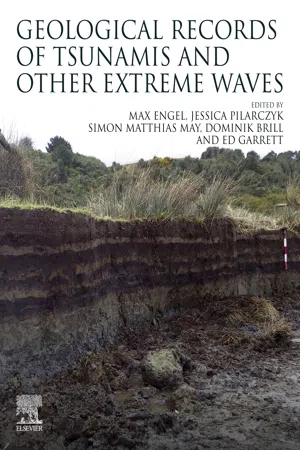
Geological Records of Tsunamis and Other Extreme Waves
- 848 pages
- English
- ePUB (mobile friendly)
- Available on iOS & Android
Geological Records of Tsunamis and Other Extreme Waves
About This Book
Geological Records of Tsunamis and Other Extreme Waves provides a systematic compendium with concise chapters on the concept and history of paleotsunami research, sediment types and sediment sources, field methods, sedimentary and geomorphological characteristics, as well as dating and modeling approaches. By contrasting tsunami deposits with those of competing mechanisms in the coastal zone such as storm waves and surges, and by embedding this field of research into the wider context of tsunami science, the book is also relevant to readers interested in paleotempestology, coastal sedimentary environments, or sea-level changes, and coastal hazard management.
The effectiveness of paleotsunami records in coastal hazard-mitigation strategies strongly depends on the appropriate selection of research approaches and methods that are tailored to the site-specific environment and age of the deposits. In addition to summarizing the state-of-the-art in tsunami sedimentology, Geological Records of Tsunamis and Other Extreme Waves guides researchers through establishing an appropriate research design and how to develop reliable records of prehistoric events using field-based and laboratory methods, as well as modeling techniques.
- Features a comprehensive overview of the state of the art in tsunami sedimentology and paleotsunami research
- Offers advice on the most appropriate mapping, sampling, and analytical approaches for a wide variety of coastal settings and sedimentary environments
- Provides methodological details for field sampling and the most important proxy analyses
Frequently asked questions
Information
Chapter 1: Geological records of tsunamis and other extreme waves: concepts, applications and a short history of research
Abstract
Keywords
Introduction
Table of contents
- Cover image
- Title page
- Table of Contents
- Copyright
- Contributors
- About the Editors
- Preface
- Section 1. Introduction
- Section 2. Field methods
- Section 3. Fine-grained deposits
- Section 4. Coarse-clast deposits
- Section 5. Dating
- Subject Index
- Event Index
- Geographic Index